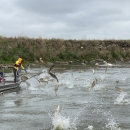Species that are considered high risk have a well-documented history of invasiveness in at least one location globally, and a high or medium climate match to the contiguous United States.
P. clarkii is known to outcompete native crayfish and rapidly take over habitat where it invades. It is an agricultural pest and has been shown to reduce populations of native macrophytes, amphibians, mollusks, macroinvertebrates, and fish. Furthermore, it alters the ecosystem it inhabits, changing water quality and sediment characteristics. P. clarkii is a vector for multiple OIE-reportable diseases. In the US, this species is an extremely popular food item, and has escaped from aquaculture in many areas. Climate match is high for every state in the contiguous US, and as this species is known to have adverse impacts, the overall risk is high.



